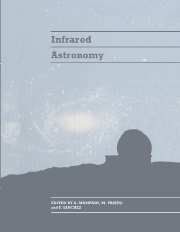Book contents
- Frontmatter
- Contents
- List of Participants
- Preface
- 1 Star Formation
- 2 Last Stages of Stellar Evolution
- 3 The Milky Way Galaxy and the Galactic Centre
- 4 Galaxies in the Infrared
- 5 Cosmology
- 6 G25.2+0.2, a New Ring Nebula Around a Luminous Blue Star: Case Study for the Importance of IR Observations
- 7 Two Colloquia on Cosmic Dust
- 8 Infrared Instrumentation
- 9 Infrared Astronomy with Satellites
7 - Two Colloquia on Cosmic Dust
Published online by Cambridge University Press: 23 December 2009
- Frontmatter
- Contents
- List of Participants
- Preface
- 1 Star Formation
- 2 Last Stages of Stellar Evolution
- 3 The Milky Way Galaxy and the Galactic Centre
- 4 Galaxies in the Infrared
- 5 Cosmology
- 6 G25.2+0.2, a New Ring Nebula Around a Luminous Blue Star: Case Study for the Importance of IR Observations
- 7 Two Colloquia on Cosmic Dust
- 8 Infrared Instrumentation
- 9 Infrared Astronomy with Satellites
Summary
Early measurements of the interstellar extinction curve at visual wavelengths (Stebbins et al., 1939) established a broad result which has survived unchanged, namely that the amount of the extinction on a magnitude scale has an approximately linear dependence on wavenumber, i.e. Aλ ∝ 1/λ. This result was later refined (Nandy 1964a, b, 1965) to show that in a second order of approximation Aλ could be represented in a plot against 1/λ, by two straight line segments intersecting at 1/λ ≅ 2.4 (μm−1), with the segment corresponding to blue wavelengths being somewhat shallower in slope than the segment corresponding to red wavelengths. The shape of the interstellar extinction curve over the waveband 1 < λ−1 λ 3μm−1 remained more or less invariant from star to star. Grain models were thus constrained to possess a wavelength dependence of extinction that accorded with this general result.
Another observational criterion that was available from the 1930's related to the amount of the interstellar extinction per unit path length. For instance at the visual wavelength, corresponding to 1/λ = 1.8 (μm)−1, the mean extinction of starlight in directions close to the galactic plane is about 2 mag/kpc.
A further result of relevance is the so-called Oort limit for the total mass density of interstellar material – gas and dust – which amounts to ˜ 3 × 10−24 g cm−3 (Oort, 1932, 1952). The dust grain density had certainly to be less than this value, probably considerably less, in view of the fact that the bulk of cosmic material is made up of H which cannot by itself condense into solid grains at a temperature above that of the cosmic microwave background, ˜ 2.7°K.
- Type
- Chapter
- Information
- Infrared Astronomy , pp. 275 - 334Publisher: Cambridge University PressPrint publication year: 1994
- 1
- Cited by



